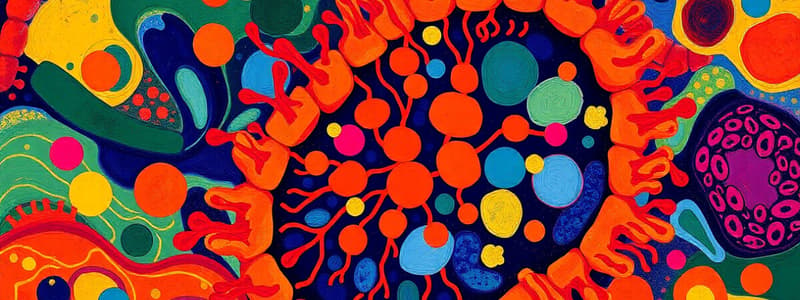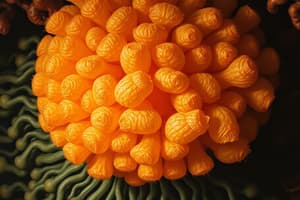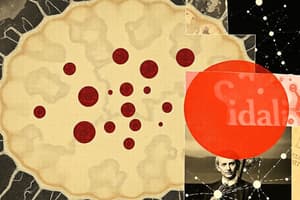Podcast
Questions and Answers
What is the first event that occurs after mRNA leaves the nucleus?
What is the first event that occurs after mRNA leaves the nucleus?
- N-linked glycosylation in the RER
- Posttranslational modification in the Golgi
- Translation of mRNA into proteins (correct)
- Packaging of proteins into vesicles
Which amino acids are directly involved in O-linked glycosylation?
Which amino acids are directly involved in O-linked glycosylation?
- Methionine and Cysteine
- Tyrosine and Glycine
- Asparagine and Glutamine
- Threonine and Serine (correct)
What is the primary function of the Golgi apparatus?
What is the primary function of the Golgi apparatus?
- To recycle cellular waste
- To modify, sort, and transport proteins (correct)
- To produce ribosomal RNA
- To synthesize DNA from RNA
Which modification process involves trimming sugar residues to activate proteins?
Which modification process involves trimming sugar residues to activate proteins?
Which of the following pathways does NOT involve protein recycling?
Which of the following pathways does NOT involve protein recycling?
What function do clathrin proteins serve within the Golgi apparatus?
What function do clathrin proteins serve within the Golgi apparatus?
Which type of glycosylation is characterized by the addition of sugar residues to hydroxyl groups?
Which type of glycosylation is characterized by the addition of sugar residues to hydroxyl groups?
Which sequence of processes best describes protein modification and transport after synthesis?
Which sequence of processes best describes protein modification and transport after synthesis?
What is the consequence of phosphorylating mannose residues on proteins?
What is the consequence of phosphorylating mannose residues on proteins?
What is the structure of the Golgi apparatus primarily composed of?
What is the structure of the Golgi apparatus primarily composed of?
Which face of the Golgi apparatus is concave and faces the cell membrane?
Which face of the Golgi apparatus is concave and faces the cell membrane?
What do COP-II proteins in vesicles primarily direct?
What do COP-II proteins in vesicles primarily direct?
During posttranslational modifications, what occurs within the lumen of the Golgi apparatus?
During posttranslational modifications, what occurs within the lumen of the Golgi apparatus?
What happens to proteins after they undergo modifications in the Golgi lumen?
What happens to proteins after they undergo modifications in the Golgi lumen?
Which proteins are involved in the retrograde transport from the cis Golgi back to the RER?
Which proteins are involved in the retrograde transport from the cis Golgi back to the RER?
What role do lysosomes play in the cell?
What role do lysosomes play in the cell?
What is the primary function of lysosomes within a cell?
What is the primary function of lysosomes within a cell?
What does cisternal progression in the context of the Golgi apparatus refer to?
What does cisternal progression in the context of the Golgi apparatus refer to?
Which cellular structure is commonly referred to as 'garbage collectors'?
Which cellular structure is commonly referred to as 'garbage collectors'?
Which of the following statements about cellular processes is FALSE?
Which of the following statements about cellular processes is FALSE?
Which protein is responsible for directing vesicle movement from the RER to the cis Golgi?
Which protein is responsible for directing vesicle movement from the RER to the cis Golgi?
In O-linked glycosylation, which amino acids are involved in adding a sugar residue?
In O-linked glycosylation, which amino acids are involved in adding a sugar residue?
Which molecule serves as a marker for proteins destined for lysosomal degradation?
Which molecule serves as a marker for proteins destined for lysosomal degradation?
Which structure is primarily responsible for the sequential modification and sorting of proteins?
Which structure is primarily responsible for the sequential modification and sorting of proteins?
Which type of cells exhibits a prominent Golgi apparatus due to high protein secretion levels?
Which type of cells exhibits a prominent Golgi apparatus due to high protein secretion levels?
What protein is responsible for retrograde transport to the rough endoplasmic reticulum?
What protein is responsible for retrograde transport to the rough endoplasmic reticulum?
Which modification adds sugars to hydroxyl groups of specific amino acids?
Which modification adds sugars to hydroxyl groups of specific amino acids?
What directs proteins to be packaged into lysosomes?
What directs proteins to be packaged into lysosomes?
Which process is characterized by the release of proteins from a cell?
Which process is characterized by the release of proteins from a cell?
What structure is formed during endocytosis to facilitate protein recycling?
What structure is formed during endocytosis to facilitate protein recycling?
What is the primary role of the cis Golgi in the Golgi apparatus?
What is the primary role of the cis Golgi in the Golgi apparatus?
Which protein coats vesicles responsible for transporting proteins from the rough endoplasmic reticulum to the Golgi apparatus?
Which protein coats vesicles responsible for transporting proteins from the rough endoplasmic reticulum to the Golgi apparatus?
What is the primary function of the Golgi apparatus?
What is the primary function of the Golgi apparatus?
Which process occurs in the Golgi apparatus that involves the addition of sugar molecules to proteins?
Which process occurs in the Golgi apparatus that involves the addition of sugar molecules to proteins?
Which part of the Golgi apparatus is responsible for sending modified proteins to their final destinations?
Which part of the Golgi apparatus is responsible for sending modified proteins to their final destinations?
After being modified in the Golgi apparatus, proteins can be sent to various locations. Which of the following is NOT a destination for these proteins?
After being modified in the Golgi apparatus, proteins can be sent to various locations. Which of the following is NOT a destination for these proteins?
What characterizes the trans Golgi compared to the cis Golgi?
What characterizes the trans Golgi compared to the cis Golgi?
Flashcards are hidden until you start studying
Study Notes
Golgi Apparatus Structure and Function
-
Golgi apparatus: A cellular organelle comprised of flattened, stacked membrane-bound sacs known as cisternae. It functions primarily in the modification, sorting, and packaging of proteins synthesized in the endoplasmic reticulum (ER).
-
Cisternal progression: Proteins move through the Golgi in a sequential process, starting from the cis Golgi (receiving end, facing the ER), progressing through the medial Golgi, and ending at the trans Golgi (sending end, facing the cell membrane or lysosomes).
-
Protein modification: The Golgi modifies proteins through various processes, including glycosylation (addition of sugars), phosphorylation (addition of phosphate groups), and proteolytic cleavage (removal of amino acid sequences). These modifications determine the final destination and function of the protein.
-
Glycosylation:
- N-linked glycosylation: Involves attaching sugar residues to an asparagine amino acid within the protein. Plays a role in protein folding, stability, and signaling.
- O-linked glycosylation: Involves attaching sugar residues to the hydroxyl group of serine or threonine amino acids. Contributes to protein folding, stability, and cell-cell interactions.
-
Phosphorylation: Involves the addition of a phosphate group to a protein, often influencing its activity or signaling capacity. For example, phosphorylation of mannose residues in proteins signals their destination to lysosomes for degradation.
-
Vesicle transport: Proteins within the Golgi are packaged into membrane-bound vesicles. Vesicles bud from the Golgi membrane, transport proteins to their target destinations, and fuse with the recipient membrane.
-
Transport proteins:
- COP-II proteins: Assist in anterograde transport from the ER to the cis Golgi.
- COP-I proteins: Assist in retrograde transport from the cis Golgi back to the ER.
- Clathrin proteins: Help in the formation of vesicles that transport proteins to the lysosomes or the cell membrane for secretion.
-
Lysosome: A cellular organelle that acts as the 'garbage collector' of the cell. It breaks down damaged or worn-out cellular debris and recycles the components.
-
Exocytosis: The process by which proteins are released from the cell through fusion of vesicles with the plasma membrane.
-
Endocytosis: The process by which the cell membrane invaginates, forming vesicles that transport proteins for recycling or degradation.
-
Importance of Golgi: Plays a crucial role in protein synthesis, secretion, and cellular function. Particularly prominent in cells that require extensive protein secretion, such as plasma cells, goblet cells, and Paneth cells.
Studying That Suits You
Use AI to generate personalized quizzes and flashcards to suit your learning preferences.




